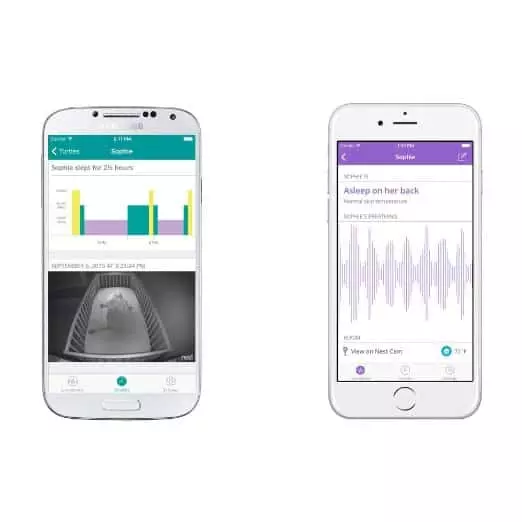Web site: MimoBaby.com
Smart Baby Monitor Brand Review: Mimo. Boston-based Mimo sells two turtle-shaped monitors: the Sleep Tracker ($143) that attaches to an all-cotton bodysuit (included) and the Activity Tracker ($180) that attaches to a crib sheet. We’ll be reviewing the Sleep Tracker here.
The Sleep Tracker monitors breathing, temperature, body position and activity level. It also tells you if your child is awake or asleep and doubles as an audio baby monitor, sending the audio as well as the health info via Bluetooth to a smart device.
The Sleep Tracker integrates with other smart gadgets in your home, namely Nest’s video camera and smart thermostat. Your baby’s nursery temperature is displayed in the app (assuming you have a Nest thermostat in the nursery). If there is motion inside your baby’s crib, you’ll see a screenshot of the moment via a Nest cam (this requires a subscription to Nest Aware).
Mimo sells this monitor with three bodysuits (size 0-3 months); an additional two-pack of compatible bodysuits runs $20 to $40.
So how does all this tech goodness work? The Mimo has a base station (called the Lilypad) that is connected to your home network via WiFi. The Lilypad also charges the monitor, which pairs to the base unit via Bluetooth.
The set-up for Mimo is fairly techy—you have to know your WiFi network’s security protocol, for example. (Quick—is yours WPA or WPA2?). The feature-rich app lets you add events, so the Mimo app can log diaper change, bottle feeding, etc.
Unlike other smart monitors that are only available online, Mimo is also sold in stores (as well as Amazon) so you can see it in person.
So how does Mimo work in the real world? The reviews are mixed. The biggest issue seems to be WiFi signal problems—Mimo needs a strong signal to remain connected and that can be an issue if your router is a good distance away. More than one parent struggled to get the Mimo connected to their WiFi network.
The app itself also gets mixed reviews—”glitchy” is how one parent described it. While Mimo does get praise for constantly improving the app (they are on version 1.4.8 as of this writing), you still get the feeling Mimo is a version 1.0 product. Some parents said their Mimo only connected about 50% of the time. Also: there can be a lag time (20-60 seconds) between your baby’s actual vitals and what the app displays—hence, don’t expect real-time performance despite the company’s claim otherwise.
One major drawback to Mimo: the Turtle monitor must be within five feet of the base station in order to work. So, yes that works when your baby is asleep in a crib. But if you take baby to another part of the house to nap, you’d be out of luck. And changing a diaper while baby is wearing the Mimo bodysuit is a chore—anyone who designs a bodysuit with nine buttons should be shot.
More than one parent complained about the hard plastic Turtle monitor; during tummy time, the concern is this would not be be very comfortable. And since some babies aren’t thrilled with tummy time to begin with, adding another obstacle is a negative.
As with all breathing and activity monitors, we’ll issue our standard warning: gadgets like Mimo are not medical devices and can’t prevent or protect against SIDS. Because Mimo bounces your baby’s vital signs off a server and then back down to your device, this isn’t a real-time monitor for babies who have medical issues.
Bottom line: Mimo is an interesting gadget that has potential—kudos to the company for integrating with other smart home elements such as the Nest cam and thermostat. But like all breathing monitors, Mimo is just for fun and amusement—and some of that fun is diminished by the techy set-up and WiFi signal requirements. Rating: Not Recommended.


 We obsess over gear for families . . . so you don't have to. Baby Bargains has one mission: help you find the best gear for your family and home with unbiased reviews by experts with 20 years of experience. At prices that don't break the bank. When you purchase a product from links on this site, we make a small affiliate commission. Learn more
We obsess over gear for families . . . so you don't have to. Baby Bargains has one mission: help you find the best gear for your family and home with unbiased reviews by experts with 20 years of experience. At prices that don't break the bank. When you purchase a product from links on this site, we make a small affiliate commission. Learn more 

Trackbacks/Pingbacks